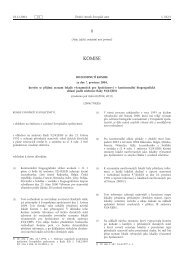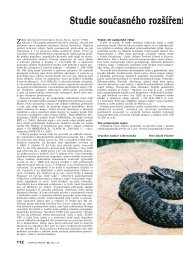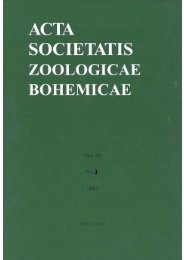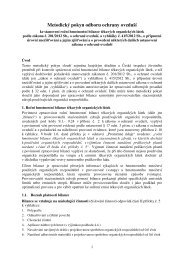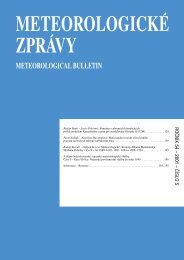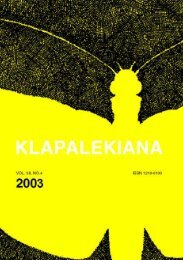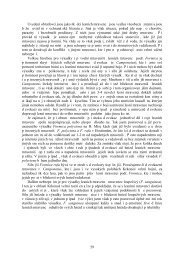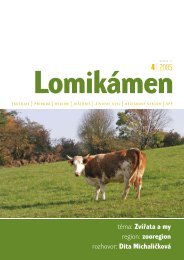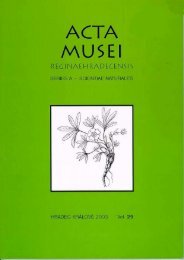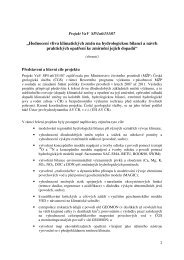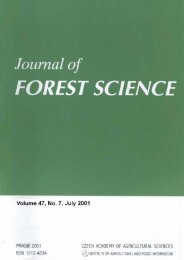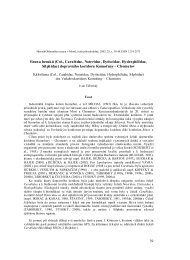Distribution and taxonomy of some Synapsis species, with ...
Distribution and taxonomy of some Synapsis species, with ...
Distribution and taxonomy of some Synapsis species, with ...
You also want an ePaper? Increase the reach of your titles
YUMPU automatically turns print PDFs into web optimized ePapers that Google loves.
Acta Soc. Zool. Bohem. 66: 321–328, 2002<br />
ISSN 1211-376X<br />
Spatial distribution <strong>of</strong> spiders (Araneae) on scree slopes in K!ivoklátsko<br />
<strong>and</strong> Moravský Kras Protected L<strong>and</strong>scape Areas<br />
Vlastimil R-ŽI'KA<br />
Institute <strong>of</strong> Entomology, Branišovská 31, CZ–370 05 'eské Bud"jovice, Czech Republic;<br />
e-mail: vruz@entu.cas.cz<br />
Received October 19, 2001; accepted January 16, 2002<br />
Published December 16, 2002<br />
Abstract. Vegetation cover significantly affects ice formation at lower margin <strong>of</strong> scree slopes. Spiders were<br />
studied on three scree slopes in the Czech Republic. The non-uniform spatial distribution <strong>of</strong> the spiders<br />
reflected the temperature gradients <strong>with</strong>in the scree slopes. Thermophilous <strong>species</strong> occured at the upper<br />
margin, <strong>and</strong> psychrophilous <strong>species</strong> at the lower margin <strong>of</strong> a scree slope. The <strong>species</strong> that occured at the dry<br />
upper margin <strong>of</strong> the scree slope tend to be the largest <strong>species</strong>.<br />
Scree slopes, ice formation, spiders, spatial distribution, size distribution, Czech Republic<br />
INTRODUCTION<br />
Accumulations <strong>of</strong> stones in Central Europe constitute isl<strong>and</strong> ecosystems (R%ži!ka 1990). Due to<br />
the difficulty <strong>of</strong> exploiting them, they are among the few ecosystems that have been little affected<br />
by man. The plant <strong>and</strong> animal communities there constitute edaphic climaxes.<br />
In <strong>some</strong> accumulations, air can flow between the stones, which allows cold air to accumulate at<br />
the bottom <strong>of</strong> a scree slope. This can lead to the formation <strong>of</strong> ice, which may persist until late<br />
spring. Because <strong>of</strong> the specific substrate <strong>and</strong> microclimate, scree slopes are inhabited by specific<br />
plant <strong>and</strong> animal communities <strong>and</strong> thus contribute significantly to the biodiversity <strong>of</strong> the l<strong>and</strong>scape<br />
(Christian 1993, R%ži!ka 1993).<br />
Spiders are well adapted to this type <strong>of</strong> habitat, <strong>and</strong> ants, probably their main competitors<br />
elsewhere, do not occur there (R%ži!ka et al. 1989, R%ži!ka & Zacharda 1994). Consequently<br />
spiders are relatively numerous <strong>and</strong> their communities relatively <strong>species</strong> rich (R%ži!ka 1989). Spiders<br />
<strong>of</strong> various boulder <strong>and</strong> stone accumulations have been studied (e.g., R%ži!ka & Kopecký<br />
1994, R%ži!ka & Zacharda 1994). This study is devoted to the spider fauna <strong>of</strong> scree slopes where<br />
the stone size is relatively small (10–20 cm).<br />
MATERIALS AND METHODS<br />
Sites<br />
Two <strong>of</strong> the study sites (Tý&ov <strong>and</strong> Branov) were in the K&ivoklátsko Biosphere Reserve <strong>and</strong> Protected L<strong>and</strong>scape<br />
Area, about 50 km west <strong>of</strong> Praha, <strong>and</strong> the third (Blansko-Skalní Mlýn) in the Moravský Kras (Moravian Karst)<br />
Protected L<strong>and</strong>scape Area, about 25 km north <strong>of</strong> Brno.<br />
The Tý&ov National Nature Reserve is located on the west slope <strong>of</strong> the Berounka river valley, approximately<br />
3 km upstream <strong>of</strong> the village <strong>of</strong> Branov, 280 m a. s. l. (Fig. 1). The lower part <strong>of</strong> the slope is covered by an<br />
Aceri-Carpinetum forest (Knížetová 1975). At the foot <strong>of</strong> the slope, inside the forest, there is a totally bare scree<br />
field about 120 m broad <strong>and</strong> 50 m high, consisting <strong>of</strong> <strong>and</strong>esite gravel 10 cm in size on average, <strong>with</strong> a slope angle<br />
<strong>of</strong> about 35°.<br />
321



